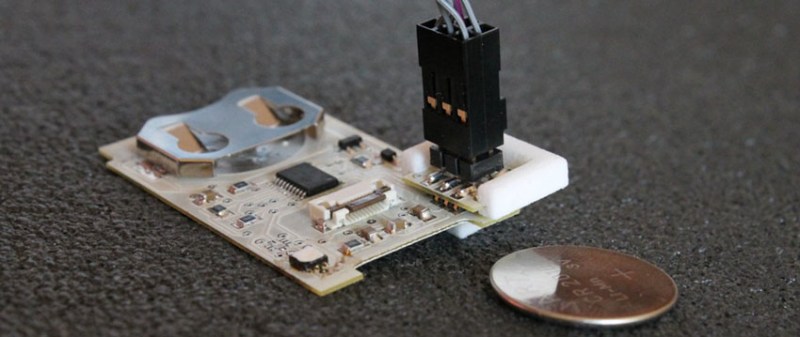Most of the hacks we see hitting the tip line are exactly that – hacked up hardware projects held together with hot glue and duct tape. [x-labs]’ entry for the 2015 Hackaday Prize, the UV badge, is certainly not one of these projects. It’s a professional one-off, capable of displaying the UV index, temperature, humidity, and pressure in one tiny little enclosure.
The UV badge is designed to be used outdoors. This means any old display ripped from a Nokia phone won’t do; that will wash out in the sun. Instead, [x-labs] is using a very sunlight-readable Sharp Memory LCD. A nice choice, as it’s an exceptionally low-power device.
Inside the 54 x 34 x 7.1 mm 3D printed enclosure is a very thin PCB, and all surface-mount components. The device is powered by a single coin cell battery that should give months of run time.
With a product designed so well, we’re wondering if the UV badge will be in the running for the Best Product category of the Hackaday Prize this year. There aren’t many projects in the running, and the winner gets a enough funding, machinery, and experience to turn their project into a product.





















That’s cool the sensor manages a linear response compared to ideal despite not being sensitive over anything shorter than UV-A. The title is misleading in that they did not manufacture the UV sensor, it’s an off the shelf part. Nor can you, as the project blog states, measure UV index as it is a calculated value.
They should consider sourcing some e-ink displays to conserve power. Wasn’t there a promo gift card or something that had small displays like that a while back? Maybe for v2 small e-ink displays will be readily available.
datsheet for the 0.99” display shows 60 microwatt draw when idle, still a decently small amount of power. maybe add a small solar cell to power it and replace the battery with a capacitor.
Memory LCDs are quite competitive with E-Inks for power usage. Depends on update rate and battery ESR which will win in practice. E-Ink update takes somewhat large currents so running it off a CR2032 may not be fun.
So, he made one of these:
http://www.overstock.com/Sports-Toys/Oregon-Scientific-EB612-Portable-UV-Monitor-with-Exposure-Timer/5126416/product.html
I have one and it has lasted years on one coin cell.
His build is more like small weather station, it measures pressure and humidity, Oregon’s one doesn’t.
Nice work. What software did you use to design the casing with?
Designed with FreeCad, 3D printed by Shapeways.